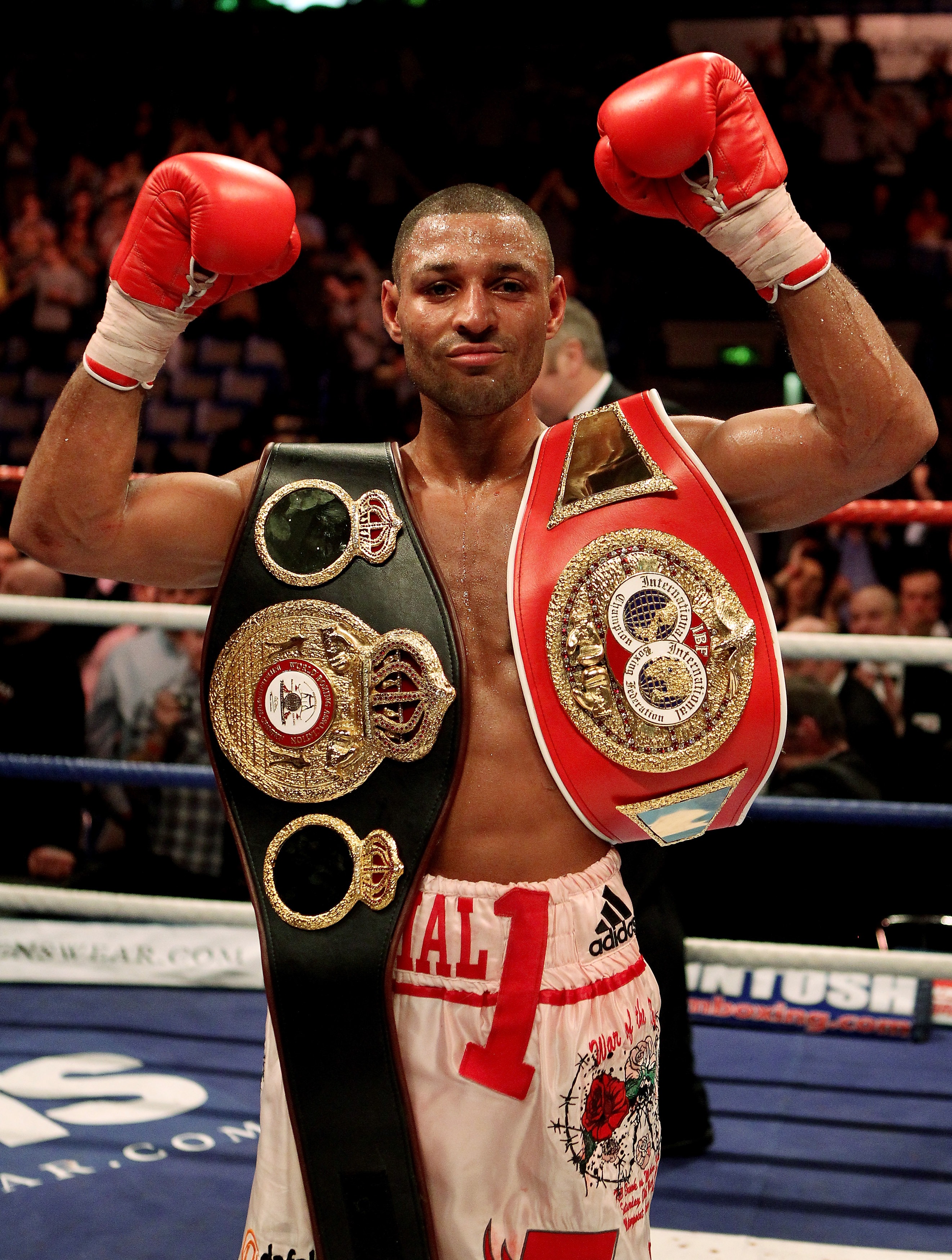BOXER Kell Brook has been filmed snorting a line of white powder at a party in his home.
Footage shows the former world champion bending over a glass-topped coffee table.
Boxer Kell Brook has been filmed snorting a line of white powder in a party at his home
Footage shows him snorting the substance through a roll-up from a glass coffee table
 Kell then appears worse for wears as he shadow boxes in front of a framed picture of him on the wall
Kell then appears worse for wears as he shadow boxes in front of a framed picture of him on the wall
More white powder is heaped next to a plastic “wrap” and the star — nicknamed Special K — mumbles “nice”.
The 36-year-old appears the worse for wear as he shadow boxes in front of a framed portrait of him having won the IBF welterweight title in 2014.
Last night his manager Terry Thompson insisted it was “a joke”.
Brook wore a T-shirt featuring boxing legend Joe Louis at the Sheffield party.
A source said: “He had a bit of a gathering at his house where people were drinking spirits and smoking.
“He was snorting white powder.”
Wife Lindsey, 35, who was often seen in the ring after his fights, and their three children were believed to be away.
Brook’s last bout was almost a year ago when he beat bitter rival Amir Khan — who in 2012 wrote on Twitter: “I’ve heard things about Kell Brook.
“He’s been seen taking cocaine.
“Boxing is a professional sport for those who have discipline and respect.”
Brook announced his retirement in May after winning 40 of 43 professional fights.
But he said recently he would return to the ring for the right offer.
He has been touted as an opponent for light-middleweight Liam Smith who beat Chris Eubank Junior last weekend.
Our source added: “Kell seems a bit lost without boxing, and it seems like it would be better for him if he made a comeback.
“He seems to be surrounded by the wrong people, who are not a good influence on him.”
Brook, who is pals with England and Manchester City footballer Kyle Walker, was brought up in a council house in Sheffield.
He began boxing aged 12 and turned professional at 18 — quickly winning title belts.
But he had problems outside the ring.
In 2007 he was stabbed in the buttocks outside a nightclub in Sheffield.
Later the same year he was slashed three times with a machete in Tenerife and needed 32 metal staples.
In 2014 he beat Shawn Porter in California to become IBF World Welterweight champion.
In 2017 he lost a fight while suffering a broken eye socket.
In 2018 he admitted suffering depression afterwards, recalling: “It ruined me.
“It was a very dark time.
“I needed counsellors, the lot.
“Words can’t describe how low I’ve been.”
Manager Mr Thompson said of the party clip: “This is a thing that has sort of got out of hand.
“They were at his house, they were having a laugh.
“They were joking about things.
“He said to them, ‘Film me having a laugh’.”
Asked if the powder was cocaine, he replied: “No.”

Kell became the IBF World Welterweight champion in 2009
Frequently Asked Questions
How long does it take to learn to box?
Boxing can be considered one of the oldest and most well-known martial arts. China recorded the first boxing match in 2200 BC. Boxing has existed for thousands upon thousands of generations. Today, boxing is still loved by celebrities and athletes. It takes approximately 10 months to master boxing.
It is difficult to learn boxing because there are so many movements. Each movement requires specific muscles to perform properly. It takes time and effort to build these muscles.
However, once you know how to move your entire body, you can then start any type of boxing technique. And over time, you’ll become more skilled at each technique.
What is Boxing?
Boxing is an intense sport in which two people attempt to knock their opponent out by hitting them in both the head or face. The object of boxing is to hit an opponent as hard as possible without hurting yourself. To achieve this, both boxers should be able to throw punches with high velocity. They also need to have good hand-eye coordination.
How does a beginner box at home?
Boxing has been around since ancient times. Boxing was created in ancient times to help warriors fight off their enemies. Today, boxing is still widely practiced around the world. Boxing is not something you need to do in a gym. A pair of gloves, punching bags and a few sparring buddies are all you need.
Amateur boxing clubs in your area can be joined and trained by professional coaches. When you are proficient in basic punches and combinations you will be ready to compete at tournaments.
Statistics
- This article received 39 testimonials and 89% of readers who voted found it helpful, earning it our reader-approved status. (wikihow.com)
- It is just like normal sparring with a partner, but you want to throw punches at 75% of your normal speed. (wikihow.com)
External Links
boxandflow.com
expertboxing.com
How To
Here are some basic skills in boxing
How to box effectively
Boxing is one of the most popular sports in the world. It involves two people who attempt to knock each other out of their heads. Different countries have different rules. There are three types generally of boxing: Amateur (Professional) and Olympic (Olympic).
Amateur boxing may be done at school, college, and university. This type of boxing allows sparring without protection. Amateur boxing contests are usually three rounds in length, lasting five minutes each. There are many styles to amateur boxing like Kickboxing. Muay Thai. Taekwondo. Karate. Judo. Wrestling.
Boxing is often practiced in gyms or clubs. They are protected by protective equipment like a mouthpiece, nose protector, shinguards, elbow pads and knee pads, waist belt, and groin protection. Professional boxing competitions have six rounds that last four minutes each. There are many types of professional boxing. These include Boxing (MMA), Kickboxing (Mixed Martial Arts), Muay Thai and Taekwondo.
Olympic boxing is performed at the Olympics. Boxers wear special protective gear, which must conform to international standards. The competition lasts eight rounds of three minutes each. Only two types of Olympic boxing are available: Light Flyweight or Heavyweight.
The basics of boxing are:
- Punching techniques
- Guarding techniques
- Footwork
- Stance
- Body movement
- Defense
- Combination
- Rotation
- Spare parts
Punching Techniques
There are seven types: Left Hook (right hook), Right Hook (uppercut), Cross (cross), Straight, Overhand, Underhand. Each punch comes with its own technique. Some punches are more powerful than others. For example, an uppercut requires great force. On the contrary, a straight punch takes less power but is faster than most punches.
There are also many combinations. These are combinations that combine punches to accomplish a particular goal. An entire combination could have several parts. A combination may include multiple parts. For example, damage to the jaw of an opponent can be caused by a left hook and a right cross.
Guard Techniques
A boxer uses his body to protect himself against attacks. He does so by using his arms, elbows and hands as well as his knees, knees and legs.
Legs
Boxers should use their legs to defend against kicks. He raises his leg when he is hit with a kick and then moves away from the opponent. To avoid being kicked on the sides, he bends at his knees when the attacker strikes from the front. He will block the kick with his foot if the attack is coming from behind.
Elbows
Because they cause great pain, elbow strikes are extremely effective. An elbow strike can be delivered either directly or indirectly. Directly means that you hit your opponent with your forearm while indirectly means that you hit him with another part of your arm.
Hands
Boxers use their arms to stop incoming blows. Boxers raise their fists to block incoming blows and then move in the direction of the attacker’s attack. Then, they touch the attacker’s hand.
Knees
Boxers who are subject to a punch to their stomachs, abdomens, or chests should bend at the knees to absorb the impact. Defense purposes are often served by knee strikes.
Feet
Boxers should respond to being attacked by their opponent by standing back and delivering counter-attacks. This will help him gain distance from his opponent. In addition, when delivering a counter-attack, a boxer should keep his balance.
Stances
To box effectively, a boxer must establish a stance. His stance will determine how he defends. It is how he positions himself and where he faces the opponent. Boxers have many options for stances. These are the most popular:
- A low stance
- High stance
- Southpaw stance
- Western stance
Moving your body
In order to win a fight, a boxer must move around his opponent. This involves changing position, speed and rhythm.
Rotation
To increase his punching power, a boxer rotates when he throws a punch. Depending on what punch is being thrown, the speed of rotation varies.
Combinations
Timing of each punch is crucial to the effectiveness of a combination. A combination that is effective starts with a strong punch, and ends with one that is weak.
Spare parts
Sparring, a boxing practice session, is designed to improve your boxing skills. Boxers learn to train their mind and bodies during sparring sessions. The purpose of sparring is, in short, to learn how fight and not get hurt.
In conclusion, learning to box requires dedication and patience. To become a better fighter, you have to train hard and continue to work.

